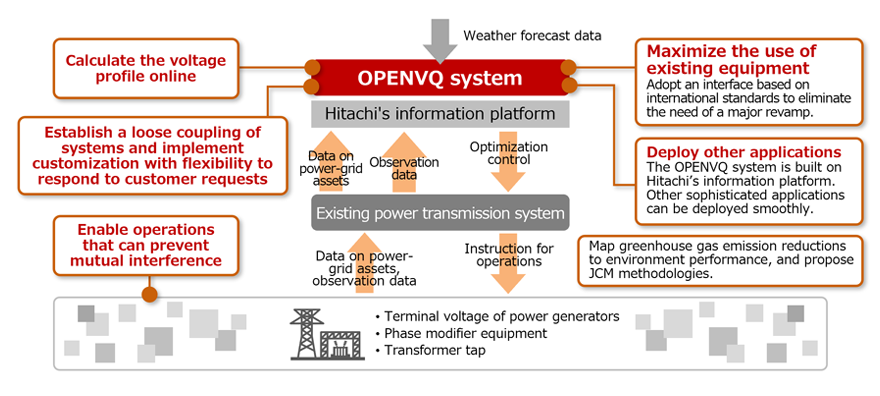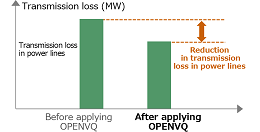Online system for optimum control of voltage and reactive power
OPENVQ (Optimized Performance Enabling Network for Volt/var (Q)) is a system that combines data on power-grid assets and monitoring data with external information (such as weather forecasts and unit commitment and dispatch results). Based on this data, OPENVQ forecasts the demand and supply balance to estimate the power-grid conditions in the near future, and thereby maximizes the performance of the power grid. OPENVQ increases efficiency by, for example, reducing transmission loss. OPENVQ can be used to increase the available transfer capability and reduce greenhouse gas emissions generated because of transmission loss.
Although NEDO's PoC project for OPENVQ is scheduled to be completed by the end of FY 2023,
the effect as expected has been confirmed by the end of FY 2022.
We welcome any inquiries about feasibility studies or any other matters before the release of OPENVQ.
OPENVQ contributes to increasing the sophistication and efficiency of power-grid operations.
Constant optimal power transmission becomes possible by using environment data (such as weather data) and by calculating the optimal voltage profile.
Also, use of the existing power grid means that large-scale equipment investments are unnecessary.

These case examples show efforts that reduced the amount of greenhouse gas emissions by introducing OPENVQ,
which increased the sophistication and efficiency of power-grid operations.
In these case examples, there was an urgent need to rapidly increase available transfer capability, even in a difficult situation in which there was an urgent need to control transmission loss, there were plans to stop thermal generation stations, and large-scale investments in facilities were not readily available.
These issues were resolved by using OPENVQ and controlling equipment by using optimal voltage profiles.



Power companies can consolidate and analyze data on power-grid assets, monitoring data, and weather forecast data and constantly use the optimum voltage profile to provide fine-grained control of the facilities. As such, companies can reduce transmission loss and increase available transfer capability.
Reduce greenhouse gas emissions caused as a result of transmission loss

Properly maintain the reliability of the power grid even after adoption of renewable energy, which involves many uncertainties

Improve the available transfer capability without large investments in reinforcing the power grid

We proposed JCM (Joint Crediting Mechanism) methodologies to quantify transmission loss.
The governments of the two countries are expressing great expectations for NEDO's PoC project for quantifying reduction of CO2 generated because of transmission loss.
Please contact Hitachi if you are interested in reducing transmission loss.
We can simulate the impact of the reductions.